|
|
Advertisement:
|
|
Abit Siluro GF4 Ti4200 OTES |
|
Join the community - in the OCAU Forums!
|
Introduction, Package and Features
Video cards based on nVidia’s TI 4200 GPU are very popular. They offer good performance for a low price. A TI 4200, even with only 64 MB memory, is handling the most demanding 3D games currently in the market. Air-cooled TI 4200 video cards are achieving 3DMark 2001 scores of up to 15,000 rivaling the much more expensive TI 4600. The GF4 is now approaching the end of the product life cycle and many video card manufacturers are upgrading their TI 4200 products to bridge the time until GF5/NV30 is out. Several TI 4200 products are now using faster 3.6 ns or even 3.3 ns memory instead of the originally used 4.0 ns memory. ABIT has gone a step further with their recently released Siluro TI 4200 OTES: in addition to faster memory the new Siluro 4200 OTES is increasing GPU performance by providing better cooling to the core. As the GF4 itself is not new anymore and has been covered numerous times (for example in our review here) we will skip another description of the GF4's features and instead focus our report on the unique aspects of the Siluro OTES card - in particular the OTES cooling system.
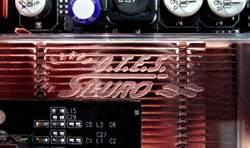
PACKAGE AND FEATURES
The Siluro OTES comes in a sturdy box. Its appearance is somewhat subdued in comparison to competing products presented in boxes with screaming colors and fancy graphics. The Siluro OTES box contains:- Installation CD including Wind DVD and ABIT propriety utility
- S-video and composite cables for TV-out in transparent design and enhanced rubber housing
- DVI to DSub adaptor
- A detailed manual and an additional brochure with information about the OTES cooling system
 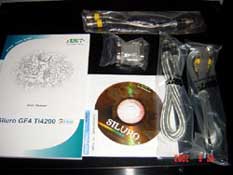
The TI 4200 Siluro OTES layout follows nVidia’s TI 4200 reference design. The card measures 7.5”, that’s a bit longer than a usual TI 4200 but still shorter than a TI 4400 or 4600. We had no problem installing the card. The PCB is black matching the PCB color of our ABIT IT7 Max 2 reference Pentium 4 board. The Ti 4200 Siluro OTES is featuring:- GPU: TI 4200 core clocked at 275 MHz
- Memory: 64 MB or 128 MB Hynix 3.6 ns RAM chips (we tested the 64 MB version) clocked at 550 MHz
- TV-out and DVI connector
- OTES cooling system
- AGP 4x / Direct X 8 support
Plan and simple: ABIT has taken their existing Siluro TI 4200, changed the memory from Hynix 4.0 ns to Hynix 3.6 ns chips, clocked the GPU and the memory like a TI 4400 and added the OTES cooling system. This looks at first glance like a quite attractive package considering that the price remains basically unchanged.
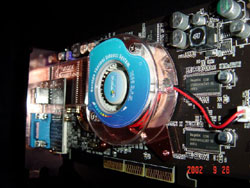 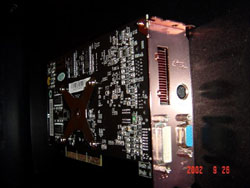 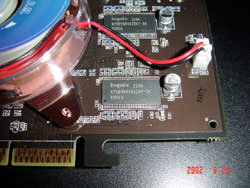 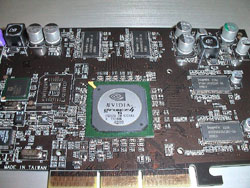
THE OTES COOLING SYSTEM
The Siluro TI 4200 highlight is the patented “OTES” called heat transfer device used for cooling the GPU. OTES stands for “Outside Thermal Exhaust System” but is more than just transporting the heat out of the case:
a) A massive heatsink absorbs the heat from the GPU
b) A heatpipe connected to the heatsink is providing additional heat absorption
b) The stream of hot air is running in a capsuled system preventing the heat from dissipating inside of the case
d) A powerful, dual bearing 7,200 rpm fan is cooling the heatpipe radiator and pushing the hot air out if the case
e) Copper is used for the entire massive cooling unit: the heatsink, the heatpipe, the radiator, and even the rear bracket
OTES is based on the well-known heat pipe principle but with some additional enhancements. The heat from the GPU is absorbed by the copper heatsink, which is connected to the OTES heatpipe, a hollow tube filled with a liquid agent. The liquid evaporates in the heat pipe’s evaporation section. The vapor carries the heat to the pipe’s condenser section. There, the vapor is condensed to liquid again, heat is released from the upper part of the pipe, the liquid returns by gravity to the lower part of the pipe, and the process starts again. The heat pipe cooling impact is further enhanced by copper (which has a better thermal conductivity than aluminum) and a specially designed radiator with lengthened fins and a powerful 7.200 rpm fan. Finally, the heat from the GPU is entirely transferred to the outside of the case because the heatsink exhaust runs through an enclosed system. There is no other way for the heated air to escape than through the exit in the rear bracket, removing the heat from the PC.
In order to accommodate the OTES heat exhaust exit, the video card’s rear bracket is double the size of regular brackets. The OTES exhaust exit and the DVI connector are occupying the lower part of the bracket. Normally, the DSUB and the TV-out connector are using the lower space (when installed). It was therefore necessary to elevate them by placing them on a small daughterboard. The double sized bracket is occupying 2 case slots. That does not constitute a problem because the PCI slot below the AGP socket is generally unusable anyway, because of the heatsink and fan present even on normal cards. Another unique feature becomes visible on the back side of the Siluro OTES: the heavy cooling unit is fastened through the PCB by 4 screws which in turn are supported by a massive metal shield providing additional cooling for the GPU. All in all: this is a sophisticated cooling design with a very solid implementation.
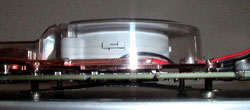 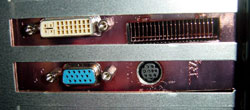
|
|
Advertisement:
All original content copyright James Rolfe.
All rights reserved. No reproduction allowed without written permission.
Interested in advertising on OCAU? Contact us for info.
|

|


